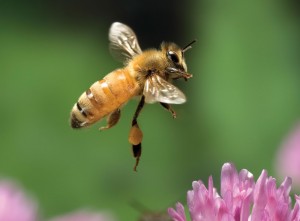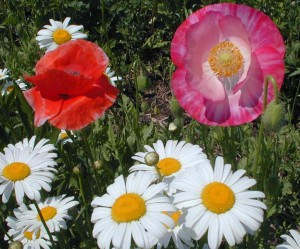Pollen goes unnoticed by most of us, except when hay fever strikes, but Pollen also offers many health benefits and is what Honey bees use to make Honey. Also microscopes reveal pollen comes in many stunning colors and shapes.
The term pollen source is what beekeepers use to identify flowers that are source of pollen for bees.
Bees collect pollen to make a protein rich food to raise their offspring.
 This is critical for the reproductive process of the plant. For the plant, the bee becomes a pollinizer and distributes its pollen. Very few flowering plants self-pollinate. The vast majority of plants, including most food crops, require a pollinator to move the pollen. There are some that rely upon on cross-pollination from a genetically different source. Without the pollinators’ activity, the plants would become extinct. Honeybees are one of the critical pollinators assisting in cross-pollination. This article discusses the pollen source from a beekeeping point of view.
This is critical for the reproductive process of the plant. For the plant, the bee becomes a pollinizer and distributes its pollen. Very few flowering plants self-pollinate. The vast majority of plants, including most food crops, require a pollinator to move the pollen. There are some that rely upon on cross-pollination from a genetically different source. Without the pollinators’ activity, the plants would become extinct. Honeybees are one of the critical pollinators assisting in cross-pollination. This article discusses the pollen source from a beekeeping point of view.
The pollen source in an area is the result of the type of plants and flowers
 The pollen source in an area is the result of the type of plants and flowers growing in an area and how long the bloom period might be. The type of vegetation that will grow in an area depends on soil texture, soil pH, soil drainage. The amount of rain, daily maximum and minimum temperatures, how cold and how long the winter period and the number of peak growing days. The plants listed below are plants that would grow in USDA Hardiness 5. A formula to predict when a plant will bloom and produce pollen is used based on the number of peak growing days.
The pollen source in an area is the result of the type of plants and flowers growing in an area and how long the bloom period might be. The type of vegetation that will grow in an area depends on soil texture, soil pH, soil drainage. The amount of rain, daily maximum and minimum temperatures, how cold and how long the winter period and the number of peak growing days. The plants listed below are plants that would grow in USDA Hardiness 5. A formula to predict when a plant will bloom and produce pollen is used based on the number of peak growing days.
The color of the pollen
The color of the pollen in the chart shows the color of the pollen freshly arrived at the hive. Bees take nectar and/or honey and mix it with the pollen and press it into a pollen basket located on the back legs of honeybees. This dry pollen is food for the bees and contains significant amounts of protein fat starch, vitamins, but little sugar. This food source is much needed for the development of the larval stage to adult worker bees. The average bee colony can collect over 100 pounds of pollen a year.
| Common name | Latin name | In Bloom | Pollen color | Availability | Source for honeybees |
|---|---|---|---|---|---|
| Maple | Acer spp. | Feb – Apr | light yellow | feral | fair |
| Manitoba Maple (Box elder) | Acer negundo | Feb – Apr | light olive | feral | good |
| Norway maple | Acer platanoides | Apr – May | yellow green, olive | feral | fair |
| Red Maple | Acer rubrum | Mar – Apr | grey brown | feral | |
| Grey Alder | Alnus incana | Feb – Apr | brownish yellow | feral | |
| American Chestnut | Castanea dentata | May – Jun | mostly ornamental | ||
| Common Hackberry | Celtis occidentalis | Apr – May | feral | ||
| Flowering Quince | Chaenomeles japonica, Chaenomeles lagenaria, Chaenomeles speciosa ‘Nivalis’, Chaenomeles x superba | Apr – May | feral | good | |
| American Hazel | Corylus americana | Mar – Apr | light green | feral and ornamental | fair/good |
| Hawthorn | Crataegus spp. | Apr – May | yellow brown | feral | fair |
| White Ash | Fraxinus americana | Apr – May | |||
| Honey Locust | Gleditsia triancanthos | May – Jun | feral | ||
| American holly | Ilex opaca | Apr – Jun | feral | ||
| Walnut | Juglans spp. | Apr – May | cultivated | fair | |
| Tulip-tree | Lirodendron tulipifera | May – Jun | cream | feral and ornamental | good |
| Crab Apple | Malus spp. | Mar – Jun | light olive | ornamental | |
| Apple | Malus domestica, Malus sylvestris | Apr – May | yellow white | cultivated and ornamental | very good |
| American Sycamore | Platanus occidentalis | Apr – May | light olive | feral | |
| Plum | Prunus spp. | Apr – May | light grey, grey | ornamental and cultivated | |
| Almond | Prunus amygdalus | Feb | light brown to brown pollen – not considered a good pollen source but bees are the primary pollinator | cultivated mostly in California | fair |
| Wild Cherry | Prunus avium | Apr – May | yellow brown, light brown | feral | very good |
| Cherry Plum | Prunus cerasifera | light brown to brown | feral | fair | |
| Sour Cherry | Prunus cerasus | Apr – May | dark yellow | ornamental and cultivated | very good |
| Peach | Prunus persica | Apr – May | reddish yellow | ornamental and cultivated | good |
| Black Cherry | Prunus serotina | Apr – May | feral | minor | |
| Blackthorn | Prunus spinosa | Mar – May | firebrick | feral | good |
| Pear | Pyrus communis | Apr – May | red yellow | ornamental and cultivated | good |
| Oak | Quercus spp. | May | feral | ||
| Oak | Quercus robur, Quercus pedunculata | May | light olive | feral | minor |
| Black Locust | Robinia pseudoacacia | May – Jun | feral | ||
| Blackberry | Rubus spp. | May – Jun | light grey | feral and cultivated | |
| Raspberry | Rubus idaeus | May – Jun | white grey | feral and cultivated | good |
| Willow | Salix spp. | Feb – Apr | lemon | feral | good |
| White Willow | Salix alba | feral | good | ||
| Goat Willow | Salix caprea | Mar – Apr | feral | very good | |
| Violet Willow | Salix daphnoides | Mar – Apr | feral | very good | |
| Pussy Willow | Salix discolor | Mar – Apr | feral and ornamental | ||
| Basket Willow | Salix purpurea | Mar – Apr | feral | very good | |
| Silky leaf osier, Smith’s Willow | Salix x smithiana | Apr – May | very good | ||
| American mountain ash | Sorbus americana | May-Jun | feral | ||
| American Elm | Ulmus americana | Feb – Apr | light grey | feral | |
| Winged Elm | Ulmus alata | Feb – Mar | pale yellow | feral | good |
| Europea field elm | Ulmus americana | feral | good |
http://en.wikipedia.org/wiki/Pollen_source
Plant pollination process
 The plant pollination process describes the vital method of sexual reproduction in plants. It enables a plant to bear fruit and seeds, many of which are not only eaten by humans, but also by other living species from birds to mammals. Birds and mammals may then distribute those seeds to new geographical locations through their droppings.
The plant pollination process describes the vital method of sexual reproduction in plants. It enables a plant to bear fruit and seeds, many of which are not only eaten by humans, but also by other living species from birds to mammals. Birds and mammals may then distribute those seeds to new geographical locations through their droppings.
